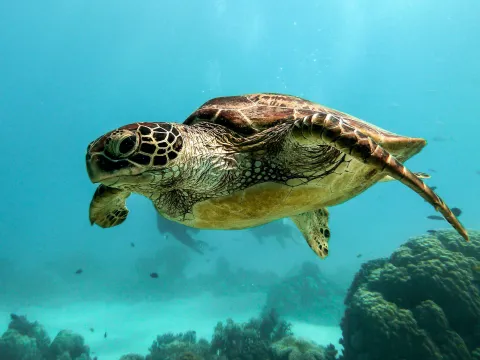Active banners: 0 Visible banners: 0
"A Hui Hou"
Provided by: Sea Walls |Published on: August 26, 2022
Articles/Websites
345678
Synopsis
- This environmental mural by Hawai'ian artist Kai Kaulukukui depicts a green sea turtle tangled in fishing lines and plastic, while a child swims beside attempting to help it.
- The mural brings attention to the massive worldwide problem of plastic waste and how ocean currents connect all regions of the Earth, while also conveying hope for the power of positive change.

Subjects: Visual and Performing Arts
Authors: Kai Kaulukukui
Region: North America, USA - West, United States, Global, Oceania, Hawai'i
Languages: English
Teaching Materials
Positives
- The artist's statement helps shed light on the deeper symbolism of the images within the mural including the red sun representing Japan, the full moon, and the subdued color palette.
- Students may enjoy seeing photographs of the artist creating this mural in the gallery.
Additional Prerequisites
- It may help students to use the interactive map to see where Hawaii is located, as they explore the interconnectedness of the oceans and how worldwide plastic usage impacts this island.
- Teachers should ensure that students have an understanding of the Hawai'ian vocabulary used in the artist's statement, such as keiki and hona.
Differentiation
- After viewing the artwork, have students watch this video outlining the environmental injustice of the global plastic recycling system and then work to make determinations about the best methods for addressing plastic usage problems across the world.
- Students could research local recycling programs to see what can actually be recycled in their own communities and make signage to help people recycle better.
- Students can work in groups to compare "A Hui Hou" with The Popo's mural in Bali addressing plastic culture and analyze the artistic methods each artist chose to address this issue.
- In art classes, students could create their own work exploring ways that people can take action for the environment, including ways to avoid lifestyle choices with a high carbon impact.
Scientist Notes
Teaching Tips
Standards
Resource Type and Format
About the Partner Provider

PangeaSeed Foundation
PangeaSeed Foundation is a globally engaged nonprofit organization acting at the intersection of culture and environmentalism to further the conservation of our oceans. Its mission is to empower individuals and communities to create meaningful environmental change for the oceans by raising public awareness of critical environmental issues through SCIENCE, EDUCATION, and ARTIVISM (S.E.A.). Through their groundbreaking Sea Walls: Artists for Oceans public art program, PangeaSeed Foundation has created over 400 educational ocean advocacy murals in 17 countries, bringing the ocean into streets across the globe.
All resources can be used for your educational purposes with proper attribution to the content provider.



